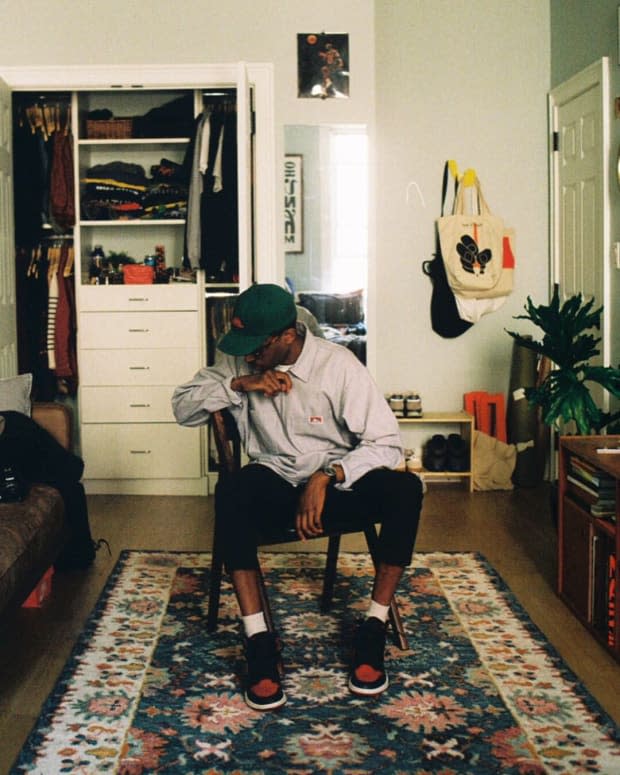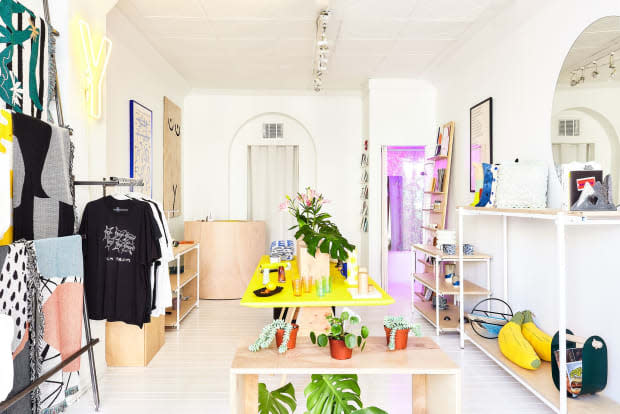For Some Menswear Enthusiasts, Rare Furniture Is as Covetable as Sneakers or Supreme
"If you spend all this money on your appearance from a clothing level, it should be a goal to have your home match your sense of style."

On the Instagram account for Lichen, a homewares and design store in the Williamsburg neighborhood of Brooklyn, it's not unusual to see the latest white-hot Nike sneakers photographed next to 1950s-era Herman Miller chairs. The personal feed of Lichen co-founder Jared Blake, a former fashion stylist, reveals a similar juxtaposition. One image displays well-worn sneakers made by the upscale brand Common Projects, the next of a perfectly aged mid-century Danish sofa, then a tote bag from in-the-know Japanese label Engineered Garments, and so on.
This exact combination — vintage furniture and sought-after menswear — speaks to a shift within a particular subculture of style-conscious men. Devotees of rare streetwear and sneakers, former prodigal children of the #menswear blogging movement who once lusted almost exclusively after clothes and shoes, anxiously awaiting every drop, have fallen under the spell of timeless furniture and boutique home goods.
"I think it's just the natural progression from caring about style," says Arsalan Jamshid, a 22-year-old student in the United Kingdom. "When I was 15 of 16, Supreme drops excited me so much. Now that I'm 22, I don't really get that same buzz from it. That's not to say that I don't still crave that buzz though — I just want it in a more grown-up way." Jamshid goes on to mention that bringing home a concrete planter from the Danish design company Hay gives him the same exciting jolt that buying a Supreme T-shirt did when he was a teenager.
For Skylar Bergl, his gravitation towards furniture was a slower pull and one that came a little later in his 20s. The 29-year-old Bergl, a former editor at the street culture publication Complex who has also contributed stories to Fashionista, says his interest in home decor perked up a couple of years ago and grew from there. "I think the two interests [fashion and furniture] are mirror images of one another," says Bergl, whose own Instagram has expanded from photos of his outfits to include shots of vintage rugs and recognizable accent chairs. "There are covetable pieces of furniture just as there are covetable pieces of clothing."
At Lichen, Blake mentions that most of the shop's customers are like Bergl, those with an eye for design who tend to work in creative fields: marketing professionals, photographers, artists and the like. Shannon Maldonado, the founder and owner of Yowie in Philadelphia, tells me her store sees a similar style-conscious customer base. "As sneakers become more complex and conceptual I think guys are starting to notice details in other things and wanting to elevate their spaces as well," she says.
"If you spend all this money on your appearance from a clothing level, it should be a goal to have your home match your sense of style," explains Blake. "One thing we try to maintain at Lichen is price points empathetic to 20- and-30-somethings. I think the want and need for better furniture have always been there, but Ikea has always been the easiest solution from a budgetary standpoint."
It's true, Ikea has been the default for many young adults jumping into post-college life in a new city — so much so that the Swedish retailer called upon Off-White and Louis Vuitton men's Creative Director Virgil Abloh for a collaboration that hits stores later this month. That is slowly changing, though, as the world of affordable direct-to-consumer furniture is booming. Taking cues from the likes Everlanes and Warby Parkers of the world, young companies have sought to deliver on the promise of better furniture than the Swedish giant. Floyd, a Detriot-based company that touts mid-century design principles, has exploded in popularity and received nearly $6 million in investor funding last year. Another player in the space, Inside Weather, offers a variety of classic, earlier-era chairs in a multitude of fabrics and finishes. (Both are just two of the many, many direct-to-consumer home brands that have sprouted up recently.)
Floyd, Inside Weather, and others aren't exactly a secret, nor are they trying to be: Their targeted ads follow you online like hawks and chances are you've seen their posters plastered all over your daily commute. The same way some are willing to pay more money for a rarer, harder-to-get article of clothing, those same people are looking to find furniture that is a cut above the stuff that all their friends and co-workers likely own.

The era of late-aughts to early-2010s "#menswear" blogging influenced how many men learned about style and design; one could discover the world of Italian tailoring in vivid detail or read an essay on the importance of Red Wing work boots, the type of in-the-weeds specifics that rarely got coverage in mainstream style publications like GQ and Esquire. This elevated the taste level and aesthetic prowess of many men. The average guy might have shopped at Gap or Banana Republic, but the #menswear guy sought out boutiques like Nepenthes or the now-shuttered Carson Street Clothiers. So, similarly to how many guys turned to Tumblr to learn about Japanese raw selvedge denim, the internet has unlocked a world of Eames chairs and Stag credenzas.
"I blame furniture Instagram," says Jamshid, referring to the platform's ability to bombard you with beautiful interiors and alluring decor. Bergl mentions a similar experience: "The moment you follow one vintage furniture dealer, another shows up on the Explore page. Then the algorithm starts feeding you minimalist design studios and furniture refurbishers, and all of a sudden there are more photos of low-profile bed frames than there are of sneakers or coats."
Vintage furniture and mid-century designers have been having a bit of moment in modern men's fashion as well. The popular streetwear blog Highsnobiety explored how the Eames Side Chair "became a streetwear canvas." (Full disclosure: I currently write a column on accent chairs for Garage.) This year, acclaimed designer Dries Van Noten worked with the estate of Verner Panton on a widely coveted collection centered on the Danish designer's beloved patterns and prints. Entireworld, the new label from menswear darling Scott Sternberg, announced a pop-up shop in partnership with furniture retailer Design Within Reach. Moreover, just this month, cool-guy retailer Kinfolk posted a lookbook chock-full of mid-century furnishings from designers like Eames, Panton, Hans Wegner and Achille Castiglioni. And last week, the cult-y T-shirt brand Boot Boyz released a now-sold-out tee covered in too many iconic chairs to count, for those who literally want to wear their love for interiors on their sleeves.
Zeus Caballero and Sean Viola are two self-described menswear enthusiasts and friends who started their New Jersey-based vintage furniture company Tri-State Modern together. The duo spent time reading the #menswear blogs back in the early 2010s, and that same passion for design and detail evolved, eventually leading them to furniture. Their company Instagram is as much their digital showroom as it is a learning experience for their followers — each post often comes accompanied by a brief history lesson on the item featured. "A large majority of our followers are in their 20s and early-30s," explains Caballero, who notes their actual customer skews a bit older. "We've also noticed that our involvement in furniture has sparked an interest amongst our peers to be more design-oriented."
The segue makes sense: The guys who cared enough about style and design to read essays on the perfect Raf Simons parka aren't going to want the same simple Ikea cabinet that everyone has. Now, instead of trying to hunt down the perfect Cerbero suede double-monk shoes, they're trying to get their hands on a set of Marcel Breuer Cesca chairs. There is a similar level of clout and hype surrounding product scarcity that comes with being "in the know" about mid-century furniture that recalls that of the menswear and streetwear spaces. Much like rare sneakers, there are individual chairs that fetch exorbitant prices based on the designer and quantity produced. You could say that the Model 92 Scissors Chair, which can sell for around $6,000 a pop, is akin to being the Air Yeezy of chairs. However, authentic mid-century wares like the Eames Side Chair or birchwood Gunlocke chairs can be found for prices ranging from $100 to a few hundred dollars. (In #menswear parlance, that's less than a price of brand-new Common Projects sneakers.)
"You can apply many of the same principles of the fashion world to furniture. There are clear parallels there," explains Bergl. "Consider how each of these is a clear reflection of who you are and what you are saying about yourself. With so many personal preferences, there's a lot of self-expression to be had between fashion and furniture."
The boys of #menswear are growing up. That means instead of being nerds about Chelsea boots, Rick Owens and Craig Green (and decorating with a random assortment of Supreme objects), they're now focused on sourcing teak credenzas and studying the work of Le Corbusier. The desire for nice things is still there. Some things change, and some things stay exactly the same — but at least guys are getting better-looking apartments out of it.
Sign up for our daily newsletter and get the latest industry news in your inbox every day.
